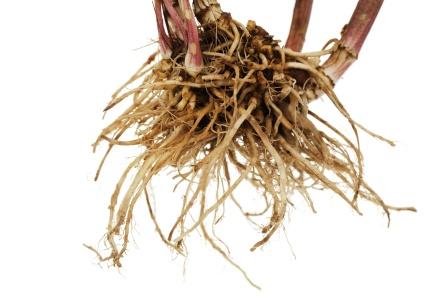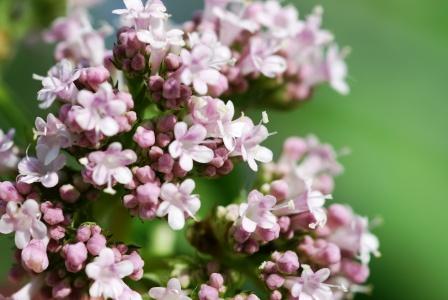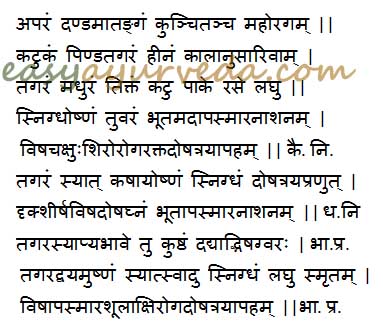Tagara Valeriana wallichii: Benefits, Remedies, Research, Side Effects
Tagara- Valeriana wallichii is a plant described in Ayurveda for the treatment of wounds, arthritis, cough, asthma, general debility, skin diseases, fever and cases of animal bite.
Latin Name- Valeriana wallichii DC
Family- Valerianaceae (Mamsi kula)

Table of Contents
Vernacular names
Names in different languages:
Hindi name- Tagar
English name- Indian Valerian
Gujarathi Name- Tagaragantoda
Kannada name- Mushka bala
Marathi Name- Tagara moola
Punjabi Name- Sugandhabala
Sanskrit synonyms
Synonyms-
Natam- The plant is short
Kutila, Vakra- The rhizome is twisted
Kalanusari, Barhishta, Barhana, Vakra, Shata, Nahusha, Nrupa,nahusha

Distribution (Utpatti sthana)
The genus Valeriana, with about 200 species, belongs to the family Valerianaceae and has a distribution throughout the world. Valeriana wallichii, the major species of the genus Valeriana is native to India, Nepal and China. In India the plant is found in the Himalayan belt at an altitude of 8000 to 10000 ft. Distributed from Kashmir to Bhutan.
The herb ‘Kushta’ (Saussurea lappa) has been mentioned as the substitute plant for Tagara in case of its unavailability.
Classical categorization
Charaka Samhita –
Sheeta Prashanama – cold relieving group of herbs
Tikta Skandha – bitter tasting group of herbs
Sushruta Samhita- Eladi gana
Vagbhata- Eladi gana
Bhavaprakasha- Karpooradi varga
Dhanvantari Nighantu- Chandanadi varga
Kaiyyadeva Nighantu- Oushadhi varga
Scientific classification
Kingdom: Plantae
Order: Dipsacales
Family: Valerianaceae
Genus: Valeriana
Species: Valeriana wallichii
Properties, part used, dosage
Tagara medicinal Properties:
Rasa (Taste) – Katu (Pungent), Tikta (Bitter), Kashaya (Astringent)
Guna (Qualities) – Laghu (Light for digestion), Snigdha (Slimy in nature)
Vipaka – Katu (Undergoes Pungent taste after digestion)
Veerya (Potency) – Ushna (Hot)
Karma (Actions) – Tridoshahara – Balances all the three Doshas, especially, Kaphavata shamaka (reduces vitiated kapha and vata dosha), Vishagna (controls the poison in the body)
Part used- Root
Dosage- Powder of root- 1-3 g
Varieties
Tagara
Pinda tagara
Chemical constituents, Uses
Chemical constituents of Valeriana wallichii:
The rhizomes and roots of the plant contain cyclopentapyrans, acacetin-7-O- rutinoside, valtrate, valepotriates and an iridoid ester glycoside, valerosidatum. The essential oil from the root contains calarene, beta- bargamotene, valeranone, ar- curcumene, maalioxide and maalitol. The main acids present in the plant are isovaleric acid and beta methyl valeric acid.
Medicinal Uses of Tagar:
- The paste of the root of Valeriana wallichii is applied over the wounds for treatment.
- The cold infusion of the root of the plant is given in a dose of 50-60 ml to treat cases of pain due to wound and infection.
- The paste of the root of Tagara is applied over the joints in cases of arthritis to relieve the pain.
- The decoction of the bark and root of the plant of Valeriana wallichii is given in a dose of 40-50 ml to treat cases of indigestion, pain in abdomen and hepatomegaly.
- The cold infusion of the root is given as a general tonic regularly for 1-2 weeks in a dose of 30-40 ml in cases of general debility.
- The decoction of the root of the plant is given in a dose of 25-30 ml to treat paralysis, convulsions, hysteria and arthritis.
- The paste of the root of tagara is applied over the area affected with insect bite and scorpion sting.
- The decoction of the root is given in a dose of 25-30 ml to treat cases of asthma and cough associated with phlegm.
- The paste of the root of tagara is applied externally over the area affected with skin diseases like discoloration and ringworm.
- The cold infusion or decoction of the bark and root is given to treat fever.
Sanskrit verse

Indications, Side effects
Indications:
Bhuta – psychiatric disorders, anti microbial
Mada – intoxication
Apasmara – Epilepsy
Visha – Toxic conditions, poisoning
Chakshuroga – eye disorders
Shiroroga – headache
Raktadosha – blood impurity and vitiation disorders such as acne, skin diseases, bleeding disorders etc
Shoola – abdominal colic pain
Tagara for sleep:
It is useful in inducing sleep as well. Dose is 1 capsule at night after food for 4 – 6 weeks. It is safe in lower doses, taken for shorter periods below 2 – 3 months time.
Side effects of Valeriana wallichii:
Patients should not take Tagara for a long duration as it may lower the blood pressure.
Hence medical supervision is advised.
People taking medicine for hypertension should seek medical advice before taking this herb.
Interaction with medicines, supplements
Can this be used while taking Homeopathic medicine?
Yes. This product does not react with homeopathic medicine.
Can this medicine be continued while taking supplements like multivitamin tablets, Omega 3 fatty acids etc?
Yes. Generally, this product goes well with most dietary supplements. However, if you are taking more than one product per day, please consult your doctor for an opinion.
With western
medicines
Seek your
doctor’s advice if you are taking this product along with other western
(allopathic / modern) medicines. Some Ayurvedic herbs can interact with modern
medicine.
If both Ayurvedic and allopathic medicines are advised together, then it is
best to take Allopathic medicine first, wait for 30 minutes and then take the
Ayurvedic medicine.
Ayurvedic formulations
Ayurvedic medicines containing Tagara:
Pippalyasava: It is an Ayurvedic medicine in liquid form and has self-generated alcohol as base. It is used to treat cases of anemia, piles, digestive complaints, respiratory disorders, sprue and liver complaints.
Devadarvarishta: Devadarvarishta is an Ayurvedic medicine, traditionally used to treat skin diseases especially occurring due to complications of diabetes. It is also useful to treat diseases caused due to Vata imbalance, difficulty in passing urine and digestive diseases.
Nalikerasavam: It is an Ayurvedic medicine in liquid form and has self-generated alcohol in small quantities. It is used to treat sexual disorders such as premature ejaculation, erectile dysfunction. This medicine is also used for longevity and rejuvenation treatment.
It improves skin quality, complexion and beauty.
Vyaghryadi lehya: It is an ayurvedic medicine in confectionary form useful to treat patients suffering from bloating, gaseous distention of abdomen, gulma, heart ailments, piles, cough, cold, bronchitis, asthma and such other respiratory diseases.
Vilvadi gulika: It is a tablet useful for the treatment of bites from cobra, scorpion, rodents, insects, spiders, gastroenteritis, dyspepsia, fever, toxic and psychological conditions.
Badradarvadi kashaya: It is a proprietary ayurvedic medicine in decoction form to treat asthma, cough and rheumatoid arthritis.
Prasootika kashaya: It is a proprietary ayurvedic medicine in decoction form to restore strength in postpartum women and to increase the quantity of breast milk.
Himasagara taila: It is an oil said in ayuveda for the treatment of locomotor problems, chest injury, emaciation, muscle wasting, locked jaw, frozen neck, frozen shoulder, speech difficulties, insomnia etc.
Chaitanya herbal jam: Chaitanya Herbal Jam is a proprietary Ayurvedic medicine useful for building immunity, alertness and vigor.
Puga khanda: Pugakhanda is an Ayurvedic medicine, in granules form. Its main ingredient is betel nut. It is used in the treatment of gastritis, vomiting, abdominal pain, dyspepsia, gastritis, bleeding diseases, anemia and constipation. It also improves strength, digestion power.
Brahamdine tablet: It is a proprietary Ayurvedic medicine used for the treatment of dysmenorrhea, menorrhagia, leucorrhoea. It also normalizes irregular periods.
Arjin tablet: It is a proprietary Ayurvedic medicine used for the treatment of hypertension.
Research
Research articles about Valeriana wallichii:
Anti- microbial action: The rhizome and root extracts of Valeriana wallichii DC in various solvents were investigated for its antimicrobial effect. The crude extracts were tested against gram positive Staphylococcus aureus, Staphylococcus epidermidis and gram negative Escherichia coli, Klebsiella pneumoniae, Pseudomonas aeruginosa, Proteus mirabilis bacteria and fungi Aspergillus niger, Candida albicans, M. furfur to find out their antimicrobial activity using agar diffusion method. Ethanol and Methanol solvent extracts showed significant antimicrobial activity ranging from 13-18mm diameter of zone of inhibition especially against fungal pathogens as compared to bacterial pathogens. In continuation with these evaluations, the most promising extract in polar solvent was investigated by GC/MS. Components identified in the solvent extract constituting Cyclopentaneacetaldehyde; Quinoline; Aristolene; Cyclohexane, 2,4-diisopropenyl-l-methyl-l-vinyl, Cyclopentane,1-(3-methylbutyl); Tricyclo[5.1.0.0(2,4)oct-5-ene-5-propanoic acid; Ascorbic acid2,6- dihexadecanoate; 9,12-Octadecadienoic acid; Pentadeconic Acid,4 hexadecyl ester; Valeric acid as the major constituents.
Toxicity study: Valerianawallcihii rhizome hydroethanolic extract didn’t exhibit mortality, morbidity or any other neurologic, hematologic or biochemical adverse effects apart from sedation which is extension of their known pharmacological activity, after single oral dose of 2000 mg/ kg bw (14 days of observation) or after once daily 200 mg/kg, 600 mg/kg 1800 mg/kg oral treatment for 90 days in healthy adult Swiss albino mice.
Anti – oxidant property: The Methanolic extracts of Valeriana wallichi were used in present study and also screened for the presence of phyto-chemicals viz. alkaloids, flavonoids, tannins, saponins, glycosides etc and their effect on 2,2-Diphenyl-1-picryl-hydraxyl radical (DPPH) which was used to determine the free radical scavenging activity.
Hepato protective action: The phytochemical study of VWE showed the presence of flavonoids, terpenoids, tannins, alkaloids and cardiac glycosides. A dose dependent increase in the oxidative potential was observed in the extracts with total phenolic content 66.4GAE/g extract. VWE 500 mg/kg and 300 mg/kg showed a significant (p<0.001) increase in levels of AST, ALT and ALP as compared to negative control (percentage hepatoprotection=73% and 68% respectively). The GSH (p<0.001) and CAT in VWE 500 mg/kg were significantly increased while MDA levels were decreased (P<0.001) as compared to negative control. The findings were confirmed histo pathological examination.
Author:
Dr.B.K.Prashanth M.D (Ayu), Ph.D
E mail: [email protected]
Morphology
Hairy perennial herb, root stalk is thick,horizontal
Leaves – Basal leaves are with long stalks, deeply cordate – ovate, toothed sharp points. Stem leaves are few in number, much smaller, entire, and pinnate.
Flowers – White or tinged with pink in a terminal corymb,ofter unisexual
Fruits – Hairy
Sthanika karma (Systemic Acton)

Externally – Reduce pain and promote wound healing. indicated in fracture, rheumatic joint diseases.
Internally
Nervous system – Improve intellect, Indicated in Tremor, Epilepsy, Insanity, Osteoarthritis, Rheumatic joint disease etc.
Digestive system – It is spicy in taste so it acts as carminative, digestive, stimulates the liver and helps to release digestive enzymes, reducing cramp. Indicated in abdominal cramp, bloating, loss of appetite, Jaundice, Ascites, splenic disorders etc.
Circulatory System – Stimulates heart, overdose may decrease Blood pressure.
Respiratory System – Being its hot potency and pungent taste it pacifies kapha dosha. Indicated in kasa(Cough) and breathing difficulties
Excretory system – Increase urine output, Indicated in urinary tract diseases
Reproductive System – Aphrodisiac Indicated in impotency, dysmenorrhea etc.
Skin – Indicated in skin disorders (Kushta and visarpa)
Tapakrama – Indicated in fever (Jeerna jvara, and in vishama jvara)
Eye – Chakshushya (Good for eyes)










4 comments
ISH
Tagara is sold by Himalaya as sleep supplement. Is it safe? At what dosage?
Dr J V Hebbar MD(Ayu)Author
It is useful in inducing sleep as well. Dose is 1 capsule at night after food for 4 – 6 weeks. It is safe in lower doses, taken for shorter periods below 2 – 3 months time.
Rahul Jethva
Can tagara be used to stabilise Apan vayu in the body ?
Dr J V Hebbar MD(Ayu)Author
Yes.